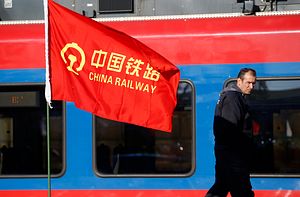One of the projects of China’s Belt and Road Initiative (BRI), a 336 kilometer rail line from Serbian capital Belgrade to Hungarian capital Budapest might take off the ground soon, according to Hungarian and Chinese officials. Construction was originally set to start in 2015.The actual start of the project was introduced during the November 2017 16+1 summit, between China and Central and Eastern European (CEE) countries at Budapest.
According to reports by the media, the railway line has the potential to become the main transport route for Chinese (and Asian) goods that arrive by sea at the Chinese-owned Greek port of Piraeus and head into Europe. According to officials, it might reduce the travel time between the two capitals from eight hours to just two-and-a-half hours with a designed maximum speed of 200 kilometers per hour. The railway is thus considered as a flagship project of China, to increase its presence in the region.
The reality, on the other hand, is a bit different – bringing into question the intentions as well.
There is a lot of false information about the project. It can reduce the travel time between Belgrade and Budapest, but since the construction documents are dealing with a maximum speed of 160 kilometers per hour (not 200 as it was stated by international and Chinese media), the trip will take three-and-a-half hours – and freight trains are not even capable of this speed. And as is clear from looking at a map, the trip from Piraeus port to CEE involves transiting not jut Hungary and Serbia but the Balkans as well, namely Macedonia and Serbian railways beyond Belgrade. These sections consist of underdeveloped infrastructure and even worse tracks.
As a Hungarian official of COSCO, the Chinese company operating Piraeus port, commented for a Hungarian news site, COSCO has already been processing exports through the Greek port since 2014, and the new railway link can not really help this process. COSCO can already transport everything, and saving four hours of travel on the Belgrade-Budapest section is overshadowed by the fact that, because of the Balkan leg, it takes around four days to reach Budapest from Piraeus by rail (with exceptions making it in three, or in a worst-case scenario, eight days).
If not to expedite trade from Piraeus, then what is the motive behind the railway? First of all, look at the details we know. In Hungary, a 152 km railway will be upgraded and constructed, creating a rail connection to the Serbian border with two tracks able to accommodate a maximum speed of 160 km per hour. As for the costs, the international media was wrong about the details, partly because of the secretive nature of the discussions. As a Hungarian journal summarized, the Hungarian section will cost 750 billion forints (roughly $3 billion). Of this, 85 percent will be financed from Chinese loans, with interest between 132 and 200 billion forints ($500 and $800 million) and 15 percent by the Hungarian government. Potentially, then, the whole project will cost around 950 billion forints ($3.7 billion). And while the construction has been already delayed, it might take another three years to start actual work: one year for the public procurement procedures (according to the general regulations within the European Union) and two years for the planning and negotiation phase. This would mean a start to the actual construction in 2021, to finish by the end of 2023 or the beginning of 2024.
Is it beneficial for Hungary to construct this railway with Chinese help? It seems that the project is more ideal for China than for Hungary.
First of all, the railway will not connect Hungarian cities (e.g. linking Budapest to Szeged, the third biggest Hungarian city). Plus, whether considering economic and trade relations or tourism, Belgrade is not a priority for Hungary. For Hungary, it is more necessary to upgrade and improve western connections, or eastern tracks toward Romania and Ukraine, either of which is more essential for economic relations.
Second, it is also important to note that while the world is considering the railway a Chinese project, as mentioned above, the Hungarian section will be financed by Hungary – 85 percent of it through loans from China’s Exim Bank, and that loan is not even interest free (though cheaper than market loans). The situation is similar in Serbia. And, according to Hungarian officials, the amount of interest depends on the share of Chinese companies in the project: less involvement by Chinese companies, higher interest; more companies, lower interest.
Which leads us to the third point: according to the plans, the railway will be constructed mostly by Chinese companies.
So, summarizing the project, Hungary is going to upgrade a 152 km railway for roughly $3 billion, plus interest of between $500 and $800 million, to fulfill China’s economic vision, with the help of Chinese loans, with the majority of the work done by Chinese companies. According to estimates, it will take between 130 and 2,400 (!) years to make the project profitable for Hungary.
Yet the Hungarian government celebrated the deal, with the foreign minister of the country saying, “We, in this region, have looked at China’s leading role in the new world order as an opportunity rather than a threat.” The railway really is an opportunity, but for China and Chinese companies rather than Hungary. With this construction project, Chinese companies will get what they have been seeking for a long time now: references within the European Union. With this railway in Hungary, a member state of the European Union, China will find it easier to win more tenders in the future within the European Community.
Dr. Zoltán Vörös, Ph.D. is an Assistant Lecturer at the University of Pécs, Department of Political Science and International Studies.
































